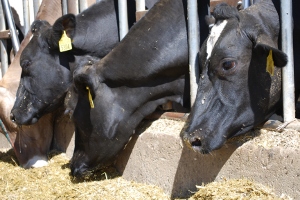By capturing methane, dairy digesters keep it out of the atmosphere. But they also create a source of renewable energy. Methane is a natural gas — it can be burned just like propane. So, Gallo Farms pipes the methane over to a generator, which produces enough electricity to run the farm and their cheese plant.
Since our visit, the story has taken an interesting turn. Both Gallo Farms and another dairy with a digester, Fiscalini Farms, are located in the San Joaquin Valley – an area with some of the worst air quality the country. The air district is consistently considered in “non-attainment” – which means they aren’t meeting the federal limits on air pollution.
While both dairies’ digesters are reducing one kind of pollution, greenhouse gases, they’re actually adding to another kind. Generators, like any other combustion engine, produce nitrous oxide pollution – or NOx – which is a component of smog. Given the smog problem in the valley, the local air district decided to put a pollution limit on the dairy digester generators.
Since then, both dairies have struggled to meet to the limits. Unlike pipeline-quality natural gas, the methane (or biogas) that comes from a digester varies in quality, which affects how much pollution is produced in the generator’s exhaust. John Fiscalini of Fiscalini Farms has spent $200,000 on a pollution control device that reduces NOx pollution. But he says it’s been a challenging process and he’s concerned that other dairies have been discouraged by his experience with regulators.
For more on Fiscalini’s story and more about the challenges facing dairy digesters, check out this week’s radio story.
 Listen to Cow Power Not Cutting It radio report online and check out the slideshow below for more on how dairy digesters work.
Listen to Cow Power Not Cutting It radio report online and check out the slideshow below for more on how dairy digesters work.
37.710486 -121.12798
 Cows at Fiscalini Farms in Modesto, California.
Cows at Fiscalini Farms in Modesto, California.